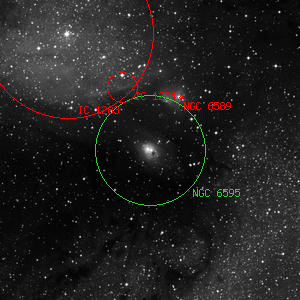NGC 6595 - NGC 6590

Overlaid DSS image of NGC 6595, 30' x 30' with north at top and west to the right
Aladin viewer for the region around NGC 6595
h 2002, GC 4395, IC 4700, LBN 43, OCl 31
| Type | Open Cluster |
|---|---|
| Magnitude | 7 |
| Size | 11' |
| Right Ascension | 18h 17' 5.0" (2000) |
| Declination | 19° 51' 58" S |
| Constellation | Sagittarius |
| Description | F, pL, cE, ** inv |
Observing Notes
Harold Corwin
NGC 6590 = NGC 6595 = IC 4700. John Herschel found the brightest nebula in this group while observing at Slough; his position is good. Swift came across it and another nearby nebula nearly 60 years later in 1885, but misplaced both by about 45 seconds of time in RA from the correct positions. In a note in AN 3101, Barnard corrected the positions for both of Swift's objects, noting the identity of NGC 6590 with NGC 6595. He also announced the discovery of another larger, though fainter nebula (IC 1284) northeast of the brighter pair. (In still another note in AN 3111, Barnard also announced the discovery of yet another nebula here, IC 1283. See that for more).
Curiously, Barnard mentions the AN 3111 note in AN 4239, but not the AN 3101 note. Had he done so, it might have alerted Dreyer to the identity of one of Barnard's nebulae mentioned there (see NGC 6589 for the passage) with NGC 6595. Had this happened, Dreyer probably would not have been included it in the second IC.
ESO, by the way, notes the cluster associated with the nebula. On the optical DSS images, the cluster appears to be centered about 15 seconds of time to the west. I suspect that the two bright stars near the center of the nebula are also involved with the nebula, so I've adopted the mean of their positions as that for the object.
Other Data Sources for NGC 6595
Associated objects for NGC 6595
Nearby objects for NGC 6595
8 objects found within 60'
| 15 Sagittarii | 16 Sagittarii | 17 Sagittarii |
| IC 1283 | IC 1284 | NGC 6567 |
| NGC 6578 | NGC 6589 |
Credits...
Drawings, descriptions, and CCD photos are copyright Andrew Cooper unless otherwise noted, no usage without permission.
A complete list of credits and sources can be found on the about page
NGC 6595